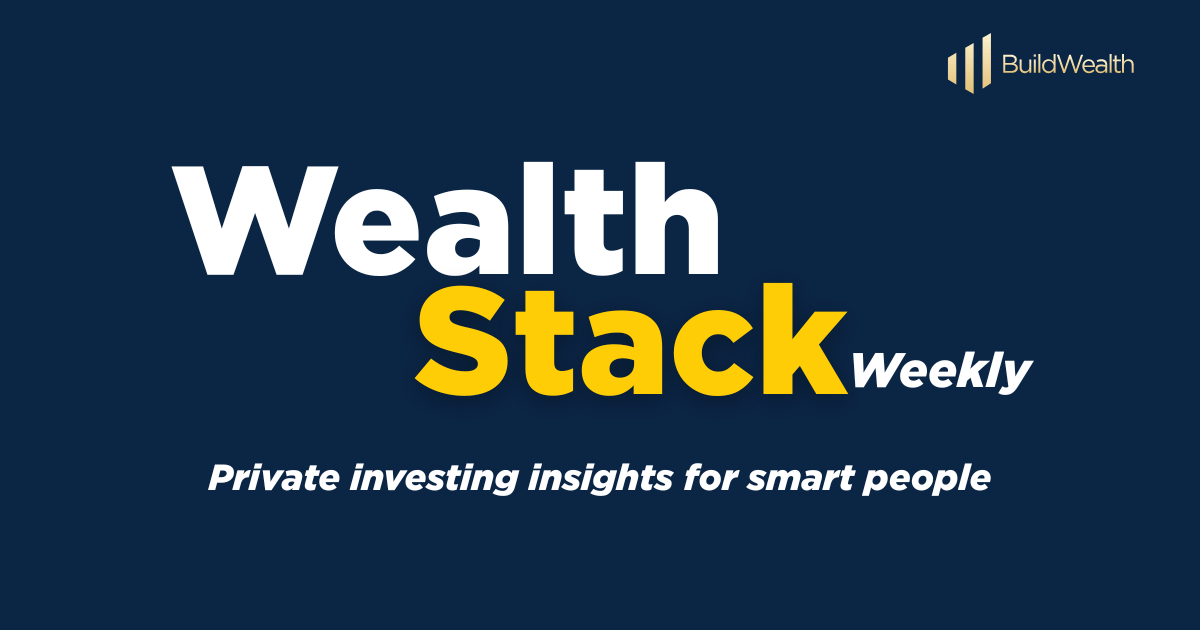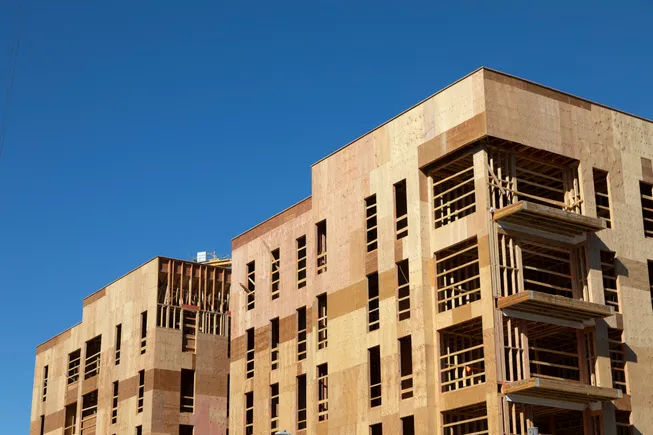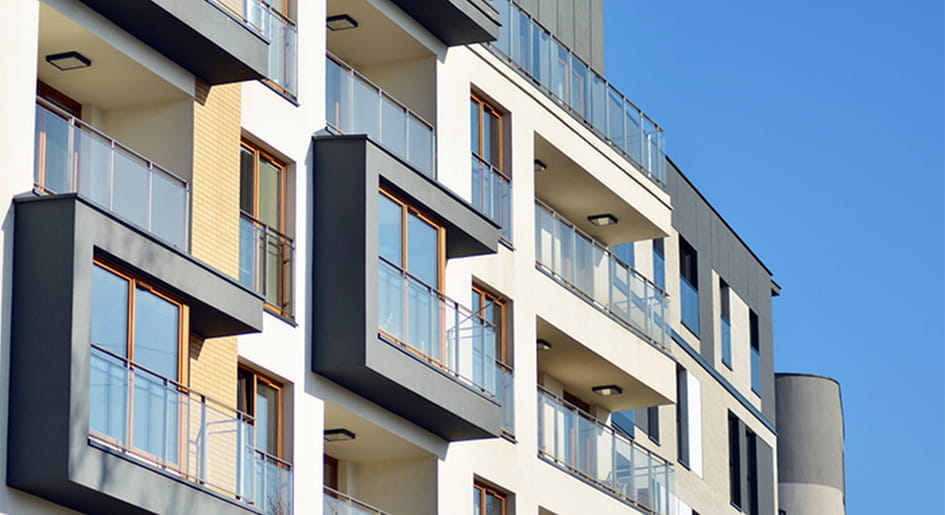- Wealth Stack Weekly
- Posts
- Don’t Buy a Building. Buy the Block.
Don’t Buy a Building. Buy the Block.
The best investors I know are compounding cash flow, control, and upside—in one concentrated move.

Hi ,
Private Equity firms are repositioning back into multifamily–quietly and deliberately.
If you know what to look for, you’ll see the parallels between today’s multifamily real estate upswing and 2013. Remember back when we were rebounding and the global financial crisis was moving further into the rear view?
At the time, most investors were still sitting frozen post-GFC. But a few stacked their portfolios with large multifamily deals and rode them to realize outsized returns for the next decade.
Today? Well the situation in the years since the pandemic is starting to mirror what we saw post financial crisis:
CRE values appear to have bottomed.
Bid-ask spreads are tightening.
New construction is down (-13% vs. 2022).
Rental demand remains strong.
And in most real estate markets, acquisition pencils better than building new.
However, not all sectors are equal. Multifamily is where a risk-adjusted upside is still turning things up, for sure, but there are additional ways to play this macrotrend.
The pros aren’t buying units. They’re building whole neighborhoods.
They’re converting obsolete office towers into 1,000+ unit income machines and
securing 90% tax abatements.
The key players in commercial real estate are building long-term wealth through cash flow, tax strategy, and strategic appreciation over their portfolios—all in a single deal.
This isn’t a 3-5 year build and flip syndication, it’s about positioning for strategic wealth building for the next decade.
We get into all these the market opportunities in this issue, specifically:
• A dive into why multifamily is the standout sector in today’s CRE cycle.
• How smart investors are stacking entire neighborhoods, not just individual units.
• A case study on NYC's record breaking $720M office-to-multifamily conversion.
• An Equity Waterfall Model you can download to help structure your next deal with precision.
Cycles never repeat exactly. But if you know where to look, they always leave a blueprint.
Let’s build it.

SHIFT YOUR STACK
The Smart Money Play is in Multifamily
It’s a formula to carry you into the next decade.
Look closely at commercial real estate today and you’ll see spooky patterns from the past. It’s 2013 all over again (minus the man buns).
While most investors weren’t ready to jump back into big bad real estate following the lessons of the GFC, the select few who gravitated to multifamily as a method to quietly lead the recovery were rewarded handsomely. Multifamily outperformed every other CRE sector over the next decade. It offered the strongest returns, the most durable demand, and the smoothest volatility.
Today, key signals once again point to CRE as the move to build wealth:
CRE values have largely bottomed.
Bid-ask spreads are narrowing as expectations reset. MSCI shows a ~6.3% YoY drop, but the floor appears to be forming.
Institutional capital is moving in, quietly and deliberately.
Multifamily is emerging as a beacon, rebuilding trust in CRE after the post-pandemic whiplash.
Why? The fundamentals are undeniable:
New supply is structurally limited—new starts are down 13% year-over-year.
Construction costs are still high, tilting the math toward acquisition.
Rental demand remains strong, anchored by strong employment (95%+), steady wage growth, and rising household formation.
Cap rates have widened, creating real entry points we haven’t seen in years.
In short, speculation has cleared out, as evidence supports now is an ideal entry time.
It’s a cleaner, more disciplined landscape—one that rewards skill, patience, and operators who know how to compound capital over time.
For long-term investors paying attention, we’ve seen this before. ; )
But here’s where the next layer of value stacking emerges.
From Multifamily to Neighborhoods
Multifamily is the foundation. But real scale, resilience, and upside emerge when it’s part of something bigger.
Neighborhood-scale investments—where residential units, retail energy, and cultural infrastructure align—unlock a different level of performance. These aren’t just properties. They’re living ecosystems where demand becomes magnetic.
When a tenant walks to a local café, a gym, a coworking space—those amenities become part of the retention strategy. They raise rents, reduce turnover, and signal community. They build stickiness.
These are the environments that outperform over decades because of structure, scarcity, and thoughtful ownership.
This is what most institutional buyers are forced to overlook due to lack of supply. And it’s where LPs often get left behind:
The value of control, curation, and momentum—layered across an entire neighborhood.
The right block outperforms the best building.
When you shape the surroundings, you influence the outcome.
IN PARTNERSHIP WITH LEGACY FUND I
What if you could acquire all four corners of the best intersection in the city—and use it to launch a long-term portfolio?
Legacy Fund I is our newest real estate investment opportunity: a 10-property portfolio in the Central West End, one of the most desirable urban neighborhoods in the Midwest.
CWE combines walkable charm, institutional demand, and a built-in moat of historic zoning and limited supply—making it one of the Midwest’s most compelling real estate submarkets.
This is a chance to co-own an irreplaceable mix of historic, cash-flowing assets, strategic add on acquisitions—plus the only developable parcel of its kind in the core of CWE.
This first acquisition seeds a 10-year, neighborhood-scale investment company focused on control, cash flow, and compounding value.
Join the Live Deal Drop: Wednesday, July 9th @ 5pm EST
Location: Virtual (Zoom)
Target Returns: 20%+ IRR | 5x Equity Multiple | 10-12% preferred return
Founding Round: $4.5M Raise Closes early August
CASE STUDY
An NYC Development Team Is Turning Two Dead Office Towers Into a $720M Multifamily Machine
The most strategic players aren’t just buying units—they’re making calculated moves at the block level, with an entire neighborhood in sight.
Case in point: Metro Loft Developers and David Werner Real Estate locked in a $720 million loan to transform two aging Midtown Manhattan office towers, which includes the former Pfizer HQ, into 1,602 multifamily units.
This isn’t a remodel. It’s the largest office-to-residential conversion in U.S. history. And it’s a blueprint for everything we’re talking about in this issue.
Don’t buy units. Invest in neighborhoods.
Metro Loft isn’t chasing 3-bed/2-bath yield. They’re reshaping urban space, unlocking tax incentives, and building long-term equity in an asset class that’s both underbuilt and in demand.
Here’s how they stacked the deal:
1,602 new apartments, 25% of which will be designated affordable
90% property tax abatement for 35 years, via NYC’s 467-m incentive
$720M one-stop loan, no messy capital stack (structured by Madison Realty Capital)
100,000+ SF of amenities and 30,000 SF of retail to anchor lifestyle value
Of course, let’s not gloss over what it takes to pull something like this off.
These conversions aren’t simply easy wins. They’re architectural and regulatory marathons. Metro Loft’s previous project (25 Water Street) in Manhattan’s Financial District was nearly an impossible conversion. They began with a massive 40,000 square foot floor plan that only had two sides of light. This is a complex logistical puzzle to lay out livable units. Fitting over 50 apartments per floor, they essentially built a new structure inside the bones of the obsolete office tower. This is a structural rethink, from pipes to sunlight.
Zoning and regulation come into play when considering a layout of a project of this size. Metro Loft got strategic in their use of the tax incentives to deliver on the project - without these the numbers might not have penciled.
But, this is what separates pros from everyone else.
While most investors are still debating whether to buy their first rental, the pros are climbing to a higher altitude. They are solving for scale, tax efficiency, and long-term tailwinds in a single move.
Thinking bigger is usually a winning strategy and for Metro Loft Developers and David Werner Real Estate, so far it’s working. The project isn’t expected to be move-in ready until the end of 2027.
This is quite the big swing. But it’s the type of thinking that can shift you from small-time landlord to Wealth Stack operator.
From collecting rent - to shaping a city block.
BEHIND THE NUMBERS
Why Neighborhood Retail Deserves a Place in Your Next CRE Move
When people think of retail real estate, they picture empty malls and fading chains. What they miss is the resilient heart of neighborhood strip centers—your local coffee shop, gym, dry cleaner, or pharmacy anchored by essential services.
Maintain 8%–9% cap rates today
Grocery-anchored strip centers are trading with yields in the high single digits—double what trophy multifamily is offering—and remain deeply under the radar compared to other retail types.
Ever heard of the Whole Foods Effect? It’s real. Apartments above premium grocers command real pricing power. According to RCLCO and reported by IREI, apartments built above a Whole Foods or Trader Joe’s command a 5.8% rent premium, and even non-luxury grocers yield a 3.3% uplift compared to comps and hover around 92%+ occupancy nationally.
But it’s not just grocers.
When tenants can walk to coffee shops, fitness studios, coworking spaces, and pet groomers—retention goes up, rent rolls strengthen, and exit multiples expand.Physical Retail Still Dominates Consumer Spending
Brick-and-mortar stores drove ~84% of U.S. retail sales in Q1 2025, versus only ~16% online—e-commerce growth has hit a plateau, while in-person shopping remains central.
During COVID, foot traffic dropped ~17%, but sales rebounded to 13–14% above pre-pandemic levels soon after lockdowns were lifted. Liquor stores, barbershops, childcare, pet groomers—these tenants needed and still need a physical home.Ride macro momentum
Brick-and-mortar retail continues growing at ~6% annually—even amid a recession, essential and experiential services hold up.Tenant risk is diversified
Neighborhood retail typically features local service-based tenants—barbers, dentists, cafés, and laundromats, and local hangouts are more integrated into daily life.
Development is limited: New retail starts remain extremely low, creating pricing power for well-located existing assets
What It Means for Your Wealth Stack
Think of neighborhood retail not as a standalone bet but as a demand-driver multiplier for your multifamily and Live / Work / Play placemaking strategy. It adds layered resilience and cash flow across the live-work-play ecosystem.
This is how it layers into your playbook:
Diversifies cash flow with high-yield retail in local markets.
Stabilizes income from essential, non-discretionary tenants.
Reduces risk through operational upside in non-institutional ownership.
Strengthens placemaking—amenities matter to residents, boosting rents and retention.
Just make sure it’s anchored in economic drivers like high employment areas or a revitalization effort.
THE PLAYBOOK
The Playbook: From Single Units to Whole Neighborhoods
It’s time to reframe how you build wealth with real estate.
Most real estate investors start small. A rental here and a duplex there. It’s a familiar guide to follow. But it rarely scales in the way it promises. Not to mention, the headaches, too little income, and no clear path to real wealth.
The wealthiest investors think differently. Not in properties, but in portfolios and neighborhoods.
Here’s how to shift your strategy and your stack:
Step 1: Move from Single-Family to Multifamily
This isn’t about collecting doors.
It’s about operating cash-flowing systems.
Multifamily gives you:
Economies of scale → lower cost per door
Resilient cash flow → vacancies don’t crater your returns
Business-grade financing → better terms, higher leverage
You’re stepping out of the landlord trap—and into an asset class built for durable growth.
Step 2: Play in the Right Markets
Capital follows fundamentals. So should you.
Target markets with:
Job growth and population growth
Limited new construction (supply constraints = pricing power)
Landlord-friendly policy
Diverse, durable economies
Buying cheap in a weak market isn’t value investing—it’s erosion in slow motion.
Step 3: Expand Your Lens—Entire Neighborhoods
Why stop at a building when you can shape the outcome of the whole block?
Savvy investors partner with operators revitalizing districts—not just flipping assets. Because when the neighborhood improves, so does your upside.
The compounding effects:
Forced appreciation
Better tenants and tenant retention
Safer, more liquid exits
Sometimes you’re the GP. Sometimes you’re the LP. Either way, you’re not just buying square footage—you’re investing in momentum.
Step 4: Choose Your Strategy—Value-Add vs. Ground-Up
Both work. Choose based on timeline, skill set, and execution team.
Newer investors? Start with value-add.
Seasoned teams? Ground-up may unlock more upside.
Step 5: Maximize Your Tax Efficiency
Multifamily is one of the most tax-advantaged asset classes available. Utilize it.
Depreciation shelters income.
Cost segregation accelerates paper losses.
1031 exchanges keep gains compounding.
A dollar saved in taxes is a dollar reinvested. That’s velocity.
Final Note: Own What You Can Influence
Multifamily gives you:
Real assets
Real income
Real control
Real impact
No tweet, headline, or Fed announcement can tank your building overnight. That’s not speculation, it’s strategy.
So Think Like a Builder
You don’t grow wealth by chasing listings.
You build it by engineering leverage, scale, and control into every asset you own.
This is the foundation of real, legacy wealth.
Let’s build it right.
WEALTH STACK TOOLBOX
Real Estate Equity Waterfall Model
→ Get the Model
This dynamic Excel tool helps you model how profits will actually flow between LPs and GPs—so you can structure smarter deals, evaluate partner offerings, and project returns with institutional clarity.
You’ll input your deal terms (preferred return, IRR or Equity Multiple hurdles, promote structure), link it to your property-level cash flow, and instantly see how each tier of the waterfall distributes capital over time. Built for integration—not standalone modeling—this is the tool pros use to align incentives and optimize deal structures.
Use It To:
Model preferred return, return of capital, and promote distributions.
Test IRR and Equity Multiple hurdles in 1–5 tier structures.
Stress test outcomes across dynamic hold periods (annual + monthly).
Evaluate GP catch-up provisions and true LP vs. GP alignment.
Integrate the waterfall module into your own DCF models.
If you’re moving from units to neighborhoods, and from retail investor to professional LP or GP—this is the next tool to master.
WHAT WE ARE READING
"Buying real estate is not only the best way, the quickest way, the safest way, but the only way to become wealthy."
Marshall Field






